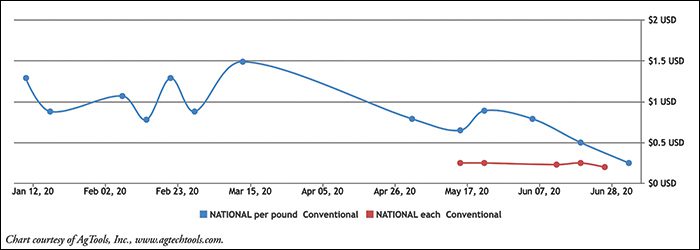Prickly Pear Market Summary

Image: Millionstock/Shutterstock.com
Prickly Pear Market Overview
The prickly pear, also known as the cactus pear or Indian fig (a top variety), is a fruit-producing cactus that thrives in arid climates. Native to Mexico, the succulent cacti, belonging to the genus Opuntia, grows naturally in many regions but has been increasingly cultivated around the world for its ability to survive in harsh environments. For this reason, it has been given many names ranging from ‘green gold’ and ‘treasure under its spines’ to ‘fruit for the poor’ and ‘sacred plant’ to animal references for the pads like bunny ears and beaver tail. The U.S. Southwest and Mexico have an abundance of prickly pear plants, as do other areas in the Western Hemisphere and subtropical latitudes. Italy, Spain, South Africa, and multiple countries in South America (especially Argentina, Brazil, and Chile) also have flourishing production. In some regions, however, it is considered an invasive plant. Prickly pear pads have a distinct flat form and are topped by flowers that produce small cylinders of fruit, often described as having a sweet, kiwi-like taste or somewhat tart melon-esque flavor. Depending on variety, cacti may or may not have spines.
Types & Varieties of Prickly Pears
There are dozens of types of prickly pear with numerous subspecies. Some are sought after for decorative purposes, though most are cultivated for the edible pads (technically the stem or branch of the cactus, often referred to as a vegetable) and its pink or magenta colored fruit. The Indian Fig (sometimes called Barbary fig) is a spineless variety and most common for human consumption. It is nearly tree sized and can grow to heights of 15 to 18 feet and 10 feet wide. Other varieties include Aissa, Algerian, Amarilla, Bianca, Cardona, Cristalina, Edwards, Gialla, Lindheimer, Morada, Ofer, Reyna, Sweet Crimson, Sweet Sunset, Turpin, and Verde. The fruit of the prickly pear is referred to as tunas (a term originating in the Caribbean islands) and the edible pads are nopales (Spanish for cactus) or if immature, nopalitos. For the Indian fig variety, the pads are light green and flowers can be white, red, yellow, pink, or purple before forming fruit. Darker varieties are usually found in the United States, with white flowers more common in Mexico. Other types include a few species of purple prickly pears and miniature versions. The Indian fig species is and has been a staple food for ages as the fruit is highly nutritional and pads store water. Once spines and seeds are removed, they can be consumed raw. Prickly pear is also often used in cooking, for making wine and other alcoholic beverages, vinegar, relish, juice, candy, jellies, chutneys, cattle forage (once spines are removed), or simply sold as an extract or in dried out form. Long used in traditional medicine, the plant is said to help regulate blood sugar and cholesterol.Cultivation of Prickly Pears
Sunny and arid desert climates are ideal for growing prickly pear, though the plants also tolerate cooler temperatures better than other cacti. This includes the Indian fig, which can do well in the chillier parts of Canada. A cactus ‘orchard’ grows well in sandy or loamy well drained soil, with little water, and can thrive in conditions that kill other plants. Better yet, prickly pear actually improves soil by sucking selenium up through roots and releasing it as a harmless gas, a process known as volatilization. Pads will grow from as small as 4 or 5 inches to 18 inches in length, with a width from 5 to 10 inches. Young pads, those with a bright green hue, are preferred for their tenderness and ample juice in the spring and summer, though pads can be harvested all year. The flowers and fruit bloom on the edges of stems or pads and generally emerge in spring, growing into an oval shape 2 or 3 inches in length though some varieties have smaller, rounder fruit. Fruit should be picked when mature and ripe, easily snapping off the pad in the summer through late fall months. Well managed orchards and cacti can produce for up to 100 years. Gloves are recommended for harvest, along with tongs to hold pads while cutting. Once harvested, spines can be scraped with a dry brush or singed off (called despination). Even spineless variations still have “glochids” or a coating of tiny spikes that may cause skin punctures and irritation. Once embedded in the skin, glochids can be difficult to remove.Pests & Diseases Affecting Prickly Pears
Cochineal scale can be a significant threat to prickly pears, and in sufficient numbers can destroy an entire cactus. Females embed themselves into the surface of pads, living off the juices before laying eggs and creating a protective white covering. Their presence is easily identified by these white, sticky splotches on pads. Other pests include borers, cactus weevils, longhorn beetles, thrips, and various types of worms. Sac fungus and viruses can be problematic, though rotation, sanitation, careful irrigation control, and removal of infected plants can help. A myriad of desert animals including birds, lizards, and snails are also known to feed on the fruit, though prickly pear’s spines and spikes ward off many. Other diseases of note include crown, dry, fruit, stem, root and stem rot, black spot, crown gall, rust, and grey mold.


